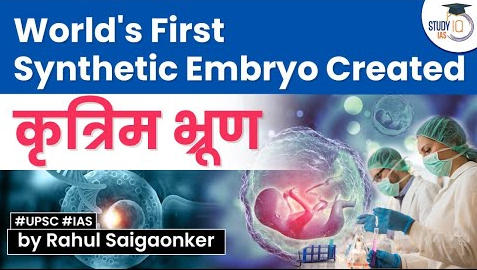Table of Contents

The News


- To create the synthetic embryos, or “embryoids,” described in the Nature paper, scientists combined embryonic stem cells and two other types of stem cells — all from mice.
- The embryonic stem cells along with two kinds of extraembryonic tissues, one of which forms the placenta and the other a sac in which the embryo develops were used. They did this in the lab, using a particular type of dish that allowed the three types of cells to come together.
- The stem cells self-organized into structures that progressed through the successive developmental stages until they had beating hearts and the foundations of the brain.

The Way Ahead
- According to Magdalena Zernicka-Goetz (University of Cambridge)
- These results could help researchers understand why some embryos fail while others go on to develop into a healthy pregnancy. It will help understand the mystery of embryos.
- The results could be used to guide the repair and development of synthetic human organs for transplantation.
- Note: In many countries human embryo research is not allowed. At present, UK law permits human embryos to be studied in the laboratory only up to the 14thday of development.
What are stem cells?

- Stem cells have the remarkable potential to develop into many different cell types in the body during early life and growth.
- When a stem cell divides, each new cell has the potential either to remain a stem cell or become another type of cell with a more specialized function, such as a muscle cell, a red blood cell, or a brain cell.

- Adult Stem cells are pretty ubiquitous in the body, appearing in many different organs and tissues including the brain, blood, bone marrow, muscle, skin, heart, and liver tissues. In these areas, they lie dormant until needed to regenerate lost or damaged tissue.
- Embryonic stem cells come from embryos that are three to five days old. At this stage, an embryo is called a blastocyst and has about 150 cells. These stem cells are pluripotent stem cells, meaning they can divide into more stem cells or can become any type of cell in the body.
- This versatility allows embryonic stem cells to be used to regenerate or repair diseased tissue and organs
- Perinatal stem cells have also been discovered to be found in stem cells in amniotic fluid as well as umbilical cord blood.
What are stem cells?

Latest Burning Issues | Free PDF






















 WhatsApp
WhatsApp